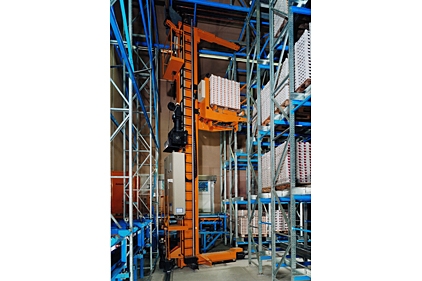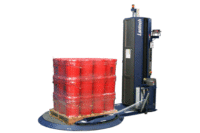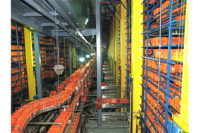ASRS Systems Streamline Throughput, Cost Efficiency

Food processors and distribution centers that operate cold storage, deep-freeze warehouses are saddled with definite challenges, particularly when wanting to  run these facilities at a high level of efficiency. Maintaining a high throughput rate with inventory and fulfillment accuracy at -10°F is more challenging than in a chilled or ambient temperature warehouse above 32°F.
run these facilities at a high level of efficiency. Maintaining a high throughput rate with inventory and fulfillment accuracy at -10°F is more challenging than in a chilled or ambient temperature warehouse above 32°F.
Compared to non-deep-freeze facilities, most manually-operated sub-zero warehouses have a higher incidence of wrong item fulfillment and poor product rotation, which increases returns, shipping costs and labor. Deep-freeze warehouses also have heightened facility, equipment and product damage, primarily caused by manually-operated forklifts impacting racks, doors, walls and product cases—significantly higher than what’s found in warehouses where temperatures are above 32°F. Personnel turnover in sub-zero warehouses is also higher than in non-deep-freeze facilities because the extreme temperatures create difficult working conditions for personnel, heightened safety issues and staff recruitment and retention problems.
Today’s deep-freeze warehouses require increased flexibility to quickly and accurately adjust to market conditions, such as increases in SKU range and shortened lead times. They need systems that will respond to retailers’ needs and get products out of the deep-freeze warehouse to retail outlets quickly and with minimal order errors.
Increasingly, frozen food producers and distributors need to track and identify where each product lot originated, where pallets came from, where they were stored, what the temperature was in storage and other critical data to keep track of their perishable inventory and ensure its product integrity. Manual handling leaves open the possibility of human error in recording and providing this data quickly with reliable and verifiable documentation.
Automation of deep-freeze warehousing can present an ideal solution to these challenges, particularly when high-bay, high-density storage utilizing automated storage and retrieval systems (ASRS) are employed.
“Automation, such as ASRS, in high-bay deep freeze warehouses reduces the cost of operation and gives an economic advantage in the marketplace,” says Ned Gregory, president, Suncup Juice, a Newark, N.J., division of Gregory Packaging, Inc., a manufacturer and distributor of frozen juice products. “By bringing the frozen product to the worker, it significantly reduces travel time by workers, wrong picks and product and facility damage, which is prevalent in contemporary deep-freeze warehouses utilizing forklift trucks.”
The latest generation of ASRS allow deep-freeze warehouses to maintain precision product identification and rotation, provide rapid throughput at near 100% accuracy levels and are considerably more energy-efficient than traditional automated systems.
Optimizing space and efficiency in deep-freeze warehouses
ASRS are computer-controlled material handling machines for automatically depositing, storing and retrieving pallet loads from defined storage locations. Central to the ASRS is the stacker crane, which permits full-pallet load and layered-pallet inventory to be moved quickly, safely and precisely within a high-bay warehouse environment. Stacker cranes offer reliability and accuracy that exceed the capabilities of forklift trucks. Such trucks, as with many manual operations in deep-freeze warehouses, transport product in only one direction, then return with an empty load.
Stacker cranes place their load into a rack position, and then retrieve a load from storage on their way out, optimizing the crane’s movements.
“Modern cranes operate within a set of top and bottom rails, which stabilize the crane, allowing greater load capacities, as well as higher rack heights,” says Daryl Hull, president North America, LTW Intralogistics, an Emigsville, Pa.-based manufacturer of stacker cranes for high-bay warehouses, including deep-freeze facilities. “It is this capability of the stacker crane that makes possible high-bay, deep-freeze storage. There is a major benefit for a warehouse switching from manual forklift trucks to an automated deep-freeze facility utilizing stacker cranes—that benefit is exemplified in maximized building volume and increased cost efficiency through high-bay accessibility.”
Forklift trucks are limited to a maximum reach of around 32 feet, allowing for pallets to be placed into four vertical positions on the rack system. If a deep-freeze warehouse needs to store more pallets, the only way it can go is horizontally by expanding the footprint of the warehouse or building another deep-freeze to accommodate the additional pallet locations.
Conversely, within deep-freeze high-bay warehouses, it is possible to have as many as 25 vertical pallet positions on racks 145 feet high. For the deep-freeze warehouse environment, this is an important efficiency factor in footprint consolidation. It can handle the same number of pallets, but on a smaller footprint. More importantly, the footprint reduction becomes an increasingly critical factor in energy savings since much of the cold loss in a sub-zero warehouse occurs through the roof.
Those high-bay, deep-freeze warehouses that are the most energy and cost efficient have achieved a high density of space utilization. This means they have a space configuration that allows for the maximum number of pallet positions to fit into the facility.
Automation engineered for deep-freeze warehouses
Not all automated warehouse equipment performs well at -10°F. The most high-speed and durable material handling equipment capable of a high-level performance at ambient or chilled temperatures would have difficulty operating in a deep-freeze environment.
Recent developments in automated storage and retrieval systems provide significant benefits for deep-freeze warehousing. These automated systems reduce warehouse labor, improve accuracy in inventory and order fulfillment, lessen product and facility damage and streamlined energy usage.
Load handling. The latest designs of stacker cranes for use in high-bay deep-freeze warehouses can carry multiple pallet types with payloads over 3,000 pounds total, traveling at vertical speeds of 325 feet-per-minute (FPM) and achieving horizontal travel speeds of 787 FPM. High-speed PLCs with integrated controls monitor the movements of the cranes in coordination with the warehouse management system (WMS) via Ethernet. Digital track positioning, infrared and laser guidance direct the movement of the cranes within the high bay.
From the floor level up to 145 feet tall, the ASRS stacker cranes can provide single-deep, double-deep, triple-deep and multi-deep stacking with the flexibility to handle one pallet load at a time or multi-loads. The latest stacker cranes can go three pallets deep with a telescope fork, and then with a satellite remote unit can run a pallet 40 feet into the racking—as much as 10 pallets deep—and then return back to the stacker crane.
Such systems permit rapid and efficient pallet handling and product rotation, essential to the needs of contemporary deep-freeze warehouses.
Aisle-changing capability. Most high-bay deep-freeze warehouses use ASRS cranes that are only capable of travelling in a straight line in one aisle. The limitation of such a dedicated aisle crane is that one crane is required to service each storage aisle in the warehouse. With aisle-changing stacker cranes, the number of cranes can be matched to the warehouse throughput instead of to the number of aisles.
“These cranes can be easily and quickly deployed to any aisles where pallet picking is needed, and withdrawn from aisles when picking is slow,” says Hull. “There is no need to have dedicated aisle cranes sitting around idle, unutilized, waiting for the next order.”
“Earlier models of aisle-changing equipment had limitations in their flexibility,” adds Hull. “For example, the turning radius required 20-24 feet at the aisle end to make the turn. This is not the case with the latest aisle-changing cranes. When a crane gets to the end of an aisle, the operator simply throws a switch in the cab, which moves the crane to a track running perpendicular to the aisle. The crane then smoothly rotates around the end of the aisle on a 10-foot radius curved track without leaving the track. It makes for an easy and fast transition between aisles.”
Integrated controls architecture. The most advanced models of ASRS use integrated controls architecture for material flow control. These systems integrate the ASRS with other automated equipment in the deep-freeze warehouse, creating one single, efficient transport system that provides optimum throughput under any system capacity. The ASRS’ wireless Ethernet and drives are located in a heated cabinet on the unit, while the programmable logic controllers (PLCs) and remote touch panel human machine interface (HMI) can be stationed outside the deep-freeze in a chilled or ambient temperature room. The controls system enables optimized speed and precision with ASRS positioning.
Energy efficiency. ASRS cranes are now designed to deliver energy efficiency in deep-freeze storage because of their flexibility. Warehouse cranes are typically optimized for peak throughput, performing many moves in and out of the racking. These modern systems reduce energy consumption by operating servo-motors at variable speeds depending on the demand load in the warehouse.
These systems also generate electricity from lowering their lift carriages, using their motors as a generator. Electricity is then put back into the main power supply. The system also contributes energy from friction when braking on downward vertical motion. The energy regeneration can account for up to 40% of the ASRS’ total power usage.
Load tracking. Deep-freeze high-bay warehouses are ideal operations for the precise and efficient tracking of frozen products because of their highly automated computer-controlled systems and sophisticated WMS. The warehouses’ WMS, along with PLCs in the ASRSs, are capable of monitoring batch numbers, production dates and weight as the unit loads and cases are moved through and stored in the facility.
Products arriving in the warehouse are tracked with pallet labels. Pallets are received and scanned, associating with prior electronically-received purchase orders in the WMS. They are then inducted into the automated high-bay warehouse. The WMS knows precisely what the products are and how many cases are on each pallet.
Temperature data loggers and/or radio frequency identification (RFID) tags can be employed to help monitor the temperature history of the incoming trucks, warehouse and of the product being shipped outbound.
“In a deep-freeze environment, manual product tracking can be difficult,” says Gregory. “Workers can easily make tracking mistakes in the severe cold environment. It is a huge benefit to have this function automated, particularly as the demands for product tracking in the entire supply chain are continually getting tighter.”
This level of WMS supply chain analytics allows sub-zero warehouses to maintain precise control on their products through every stage of their handling—from receiving to storage through picking and shipping.
Automated picking windows. This picking solution, utilizing ASRS stacker cranes, automatically removes a pallet from the high-bay deep-freeze allowing rack replenishment or picking of cases from pallet flow in an area that is just below or above freezing. To minimize loss of refrigeration, pick windows are just large enough to accommodate the pallet load, and open and close only long enough to complete the delivery or pallet pickup cycle.
With a partial pallet pick, once the picking is complete, the stacker crane automatically returns the pallet back into the deep-freeze warehouse for storage.
Sliding picking windows can be equipped with tunnels that separate the picking gates from the stacker crane aisles to provide a safer boundary of operation for workers. This system enables dynamic order picking of frozen goods utilizing highly automated ASRS integrated into a goods-to-person pick solution.
Streamlining deep-freeze efficiency. “The benefits of an automated high-bay warehouse, from a labor standard, are very high,” says Gregory. “It really cuts down on worker costs. Because a deep-freeze environment is so inhospitable, it makes it difficult to hire for and retain personnel for these positions. But, automated cranes can operate 24 hours a day on demand in this environment.”
By incorporating the latest improvements in high-bay stacker crane systems, a frozen foods processor or distribution center can better adapt to changing throughput dynamics, while operating at a more cost-efficient level.
“Automated storage and retrieval systems have proven themselves to be a viable method to reduce operations and distribution costs in deep-freeze warehouses,” Hull says. “These stacker cranes, both semi-automated and fully-automated, reduce the number of people required to operate the warehouse, improve picking and order accuracy and reduce product and facility damage.”
Looking for a reprint of this article?
From high-res PDFs to custom plaques, order your copy today!





